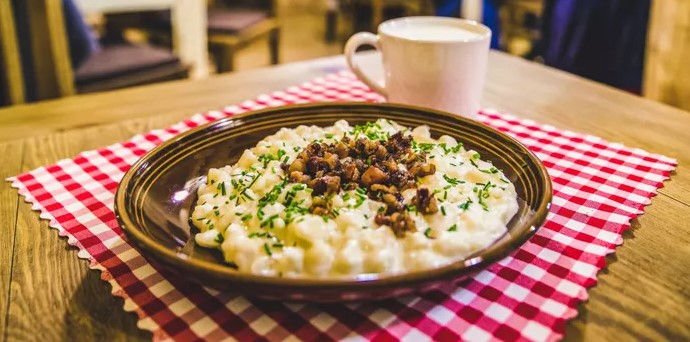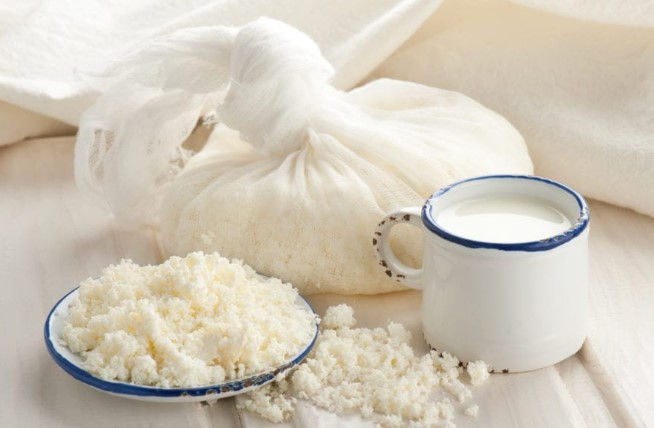Eat and drink like a Slovak
- sofia dammann
- Jul 23, 2023
- 7 min read
Updated: Feb 21
Welcome to our food and drinks section! If you are visiting our city and you have no idea what the locals in Slovakia eat or drink, don’t worry anymore - most of the people have no idea either! That’s why this short article is here to help you out with the basics.
(Pronunciation of the tricky names: c->ts, č->ch, š->sh, ž->zh, á->aa, é->ee, í->ii, ú->uu, ý->yy)
The origins of traditional Slovak cuisine can be traced to times when the majority of the population lived self-sufficiently as peasants and shepherds in the Carpathian mountains and valleys, with very limited food imports and exports and with no modern means of food preservation and processing. This gave rise to a cuisine heavily dependent on a number of staple foods rich in calories that could stand the hot summers and cold winters. These included wheat, potatoes, sheep milk and milk products, pork meat, sauerkraut, onion and garlic. All these were usually produced and processed by families themselves with some local trade at the country markets. Bread, dumplings and noodles were made from wheat, potatoes were mostly boiled or processed into potato dough. Milk was processed into a wide range of products such as butter, cream, sour cream, and various types of cheese.

That’s why, most of the time, the traditional Slovak dishes are the combination of potatoes, cabbage and/or some form of (mostly sheep milk) cheese. You should not be surprised to find some poppy seeds or nuts in your sweet meals either. There are also well known Central European meals like schnitzel, goulash and such to be found in Slovak cuisine, but these are not considered to be of Slovak origin.
Traditionally, the main meal of the day is lunch, eaten around noon (however, changing work routines has altered this in recent decades and today, many Slovaks have their main meal in the evening). Lunch in Slovakia usually consists of soup and a main course. Here are some options for your Slovak menu:
Bryndzové halušky is the Slovak national dish. This meal consists of halušky (boiled lumps of potato dough similar in appearance to gnocchi)and bryndza (a unique Slovak soft and salty sheep milk cheese similar in texture to ricotta), sprinkled with bits of fried smoked bacon. Bryndza has the status of protected geographical indication in the EU. You can find the best halušky in the city here.
Strapačky is another variety of a dish where the base compound is halušky. However, instead of bryndza, roasted sauerkraut is used, sprinkled with bits of fried smoked bacon. Good option for people with lactose intolerance.
Bryndzové pirohy are semicircular boiled dumplings filled with a mix of bryndza and mashed potatoes. These are served with some more bryndza (mixed with milk or sour cream, so it has a liquid consistency and serves as a dip) and topped with bits of fried smoked bacon. You can find the first three dishes in this article in a good presentation here.
Šúľance are rolled dumplings made of potato dough, filled with nuts or poppy seeds. These are often covered in powdered sugar, liquid butter and grinded poppy seeds. Even though sweet, this meal is not a dessert and is usually served as a main dish.
Kapustnica is a cabbage soup made of sauerkraut cooked in water with chopped pork, pieces of smoked sausage, mushrooms and diced potatoes. Kapustnica is the most popular Slovak soup and it is traditionally served as a part of the Christmas dinner.
Cesnačka is a garlic soup consisting of a thin broth, garlic, sliced potatoes and spices, typically served with fried bread cubes and grated cheese. It is usually prepared with a significant amount of garlic and without any meat. The best soup in the city is found here.
Zemiakové placky are potato pancakes fried in oil, made of chunks of grated potatoes, eggs, flour and seasoning (salt, pepper, most importantly garlic and marjoram).
Cheese forms such a popular part of Slovak cuisine that in the busiest spots around Bratislava (such as the Zochova bus stop or the Main Railway Station), cheese machines can be found. You guessed it right - these are the vending machines where one can buy his/her favorite (mostly sheep milk) cheese. Of course, we will not leave you in the dark:
Žinčica is a traditional Slovak drink made of sheep milk whey similar to kefir. This by-product in the process of making bryndza is considered to be the best supplement to bryndzové halušky.
Oštiepok, korbáčik and parenica are varieties of traditional smoked sheep milk cheese. Oštiepok is a salty and firm block of cheese (mostly in the shape of an egg), while korbáčik and parenica are semi-firm string cheese in the form of fine braids (the former) or snail-like spirals (the latter). All three have the status of protected geographical indication in the EU.
The regional cuisine is slightly different as Bratislava and its surroundings, in comparison to the rest of Slovakia, was always heavily influenced by the nearby cultures and by different climate conditions. The fundamentals of Slovak cuisine are still present though, just in a slightly more refined way:
Husacie hody is a regional late autumn festive menu consisting of roasted goose meat, goose liver, greasy lokše (pancakes made of potato dough baked directly on the stove), stewed red cabbage, and sour cherry and poppy seed strudel, famously served in the nearby village of Slovenský Grob. Out of season, a less opulent variety can be found in the restaurants around Bratislava - roasted duck meat, greasy lokše and stewed red cabbage. They have a very delicious duck here.
Bratislavský rožok is a type of kifli, characterized as a fine baker's ware or pastry filled with poppy seeds (in the form of a horseshoe) or walnuts (in the form of a letter C) and a glossy marbled surface. This pastry has been produced in Bratislava since the 16th century and was declared a traditional speciality guaranteed in the EU. You can find the best ones in the bakery area here.
Trdelník is a kind of spit cake and variant of the Hungarian kürtőskalács. It is made from sweet dough that is wrapped around a stick, then roasted over charcoal and topped with sugar and walnut mix. The origin of trdelník can be traced to the historical territory of modern Slovakia - its production has a long tradition in the town of Skalica where the original recipe was improved to its final form now known as Skalický trdelník (protected geographical indication in the EU). The only place with skalický trdelník in Bratislava can be found here.
Veterník, krémeš and punčový rez are some of the most favorite desserts that can be found in the cafés of Bratislava. These are generally the local varieties of more famous French or Austrian desserts that most likely got their most recent form in the communist period. You can find many of these cakes here.
Slovakia is a country characterized by a vast number of alcoholic beverages, especially the spirits. Generally, in Slovakia, a drink is not considered to be really alcoholic unless it contains 40% or more alcohol by volume. Thus, you won’t be surprised to find a wide array of distillates made of all possible kinds of fruits. There is also a strong tradition of viticulture here, with Bratislava and its surroundings being the most important Slovak wine region. Even though the Slovak wines are said to be of high quality, they are mostly unknown to the world. Therefore, these are the best liquid choices for your glass:
Borovička is a Slovak national alcoholic beverage, flavored with juniper berries. It is characterized by its clear or golden color, and a taste similar to that of dry gin (although much stronger). Today's commercially produced borovička typically contains about 40% alcohol by volume, but can reach as high as 50 to 70% alcohol content. It harks back to the 16th century, when this beverage was produced in the county of Liptov in northern Slovakia. Borovička has the status of protected geographical indication in the EU. You will find a great variety of borovička here.
Tatratea is a tea and herbs liqueur based on recipes developed by people living in the High Tatras mountains. It was an old custom among them, in order to protect the guest from the cold, to offer him hot tea enriched with herbal liqueur. Even though the modern Tatratea is a relatively new creation (2003), it became one of the most popular beverages in Slovakia. Its most widespread variant is 52% Original (made from black tea, herbs and raspberry extract), but there are many more on the market (range 17% to 72%). The cheapest ones can be found here.
Račianska frankovka is a red wine produced in Bratislava (specifically the suburb of Rača). This wine is made from the grape known in Slovakia as Frankovka modrá (Blaufränkisch) and it is so popular that local wine producers from Račahold an annual wine festival that highlights Frankovka modrá wines from the region and from around the globe. Another local wine worth trying in Bratislava is a very sweet ríbezlák (currant wine) from the suburb of Devín. You can find a good tasting place of Slovak wines here.
Medovina (also known as mead or honey wine) is an alcoholic beverage made by fermenting honey mixed with water and herbs, the alcoholic content usually ranging from 10% to 12%. Slovakia has a great honeymaking tradition and the mead produced by Slovak producers achieves excellent quality, as evidenced by the fact that Slovakia holds the largest number of awards for mead from world honey and mead competitions. It is most popular in its heated form on the Christmas markets. During the rest of the year, you will find the mead here.
Kofola is the most popular carbonated soft drink in the Czech Republic and Slovakia, created in the communist Czechoslovakia. In contrast with Pepsi or Coca-Cola, to which it is the principal rival in these countries, Kofola contains 30% less sugar, 56% more caffeine and does not contain phosphoric acid. Kofola is a popular option in restaurants as well, as it can be draught-poured from kegs right into a glass.
Cheers and bon appetit!























Comments